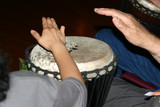How to Play the Cajon
The side of the Cajon drum that is crafted out of specific wood or fiberglass material, also known as the frontplate, is the actual playing area of the drum. The side with a hole cut into it is typically the back siding of Cajon drums and is the portion that is positioned perpendicular to the Cajon drum head or parallel to the head depending on the drum style. The tapping region on the Cajon drum is further identified as tapa or drum head.
When an individual plays Cajon, he or she positions their body above and over the box; some drummers straddle the box while playing, and others sit upon it when they play. The drummer will take the Cajon and tip them or tilt them inward in order to begin playing. The surface of the drum is then tapped with the open palm and fingertips to derive different sound effects from the instrument.
Cajon Drum: Open Tone
With a flat hand and fingers together, you will hit the front plate with the full length of all four fingers at the top of the drum. Thumb is lose.
Cajon Drum: Bass Tone
With a flat hand, this time with your fingers spread and open palm, hit the frontplate with your entire hand in the middle/upper area of your cajon.
Cajon 101 Online Lesson
In this digital drum lesson you will learn seating positions on the cajon that reduce strain on your back and how to play the basic bass and snare tones.
Recent Posts
-
X8 Drums Play-Along Backing Tracks
The new X8 Play-Along Series is being produced for our musician friends wanting a fresh way to work …9th Feb 2025 -
What is the Best Size Djembe for Beginners?
If you're new to the world of percussion and interested in learning the djembe, you're in for a t …16th Jul 2024 -
The Benefits of Becoming a Drumming Teacher: Transforming Passion into Profession
Why become a drumming teacher? Becoming a drumming teacher is an excellent way to share your pas …22nd May 2024



